
Date: November 19, 2019
Location: Lat: 23.98455°, Long: -83.386217°
Dive Depth Range: 928 - 973 meters (3,045 - 3,192 feet)
Access Dive Summary and ROV Data
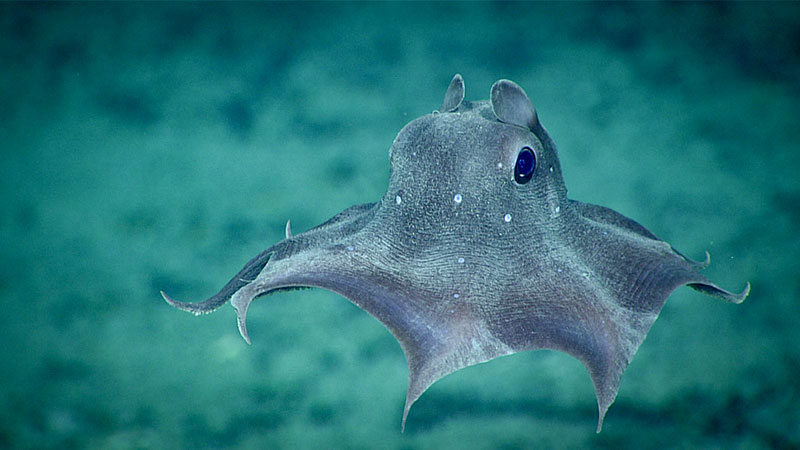
Everyone loves a flapjack devilfish. We observed this one, an Opisthoteuthis agassizii, during Dive 12 of the 2019 Southeastern U.S. Deep-sea Exploration. The dots are clear windows in the skin. We are uncertain of their purpose, but suspect they may gather additional light. Image courtesy of the NOAA Office of Ocean Exploration and Research, 2019 Southeastern U.S. Deep-sea Exploration. Download larger version (jpg, 1.1 MB).
Today’s dive, about 58 miles southwest of the Dry Tortugas, marked the final dive of the 2019 Southeastern U.S. Deep-sea Exploration and the final dive off NOAA Ship Okeanos Explorer in 2019. The area was mapped during the 2019 Okeanos Explorer shakedown expedition, and the specific site was selected because of its interesting bathymetry, which features a plateau surrounded by smaller features that resemble pieces of ice calved from an iceberg (hence the name “Berg Bits”).
During the dive, we explored two of the small features and an escarpment on the nearby plateau. The seafloor coverage varied around these features and included a mix of unconsolidated sediments, including coral rubble, small blocks of limestone (some encrusted), and exposed hardbottom.
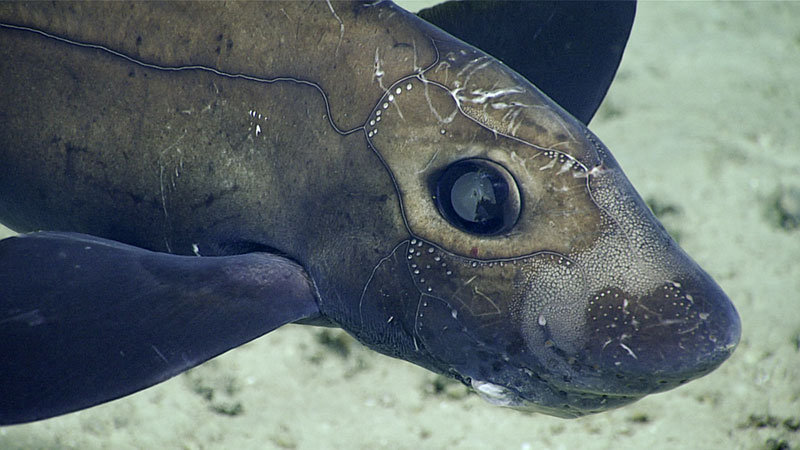
This chimaera, at roughly 50 centimeters (20 inches), was the largest and darkest we saw during the 2019 Southeastern U.S. Deep-sea Exploration. Seen during Dive 12, it really let us check it out from all angles and close up. The dots on its head are electroreceptors, ampullae of Lorenzini, that can detect minute electrical signals generated by their prey. Image courtesy of the NOAA Office of Ocean Exploration and Research, 2019 Southeastern U.S. Deep-sea Exploration. Download larger version (jpg, 1.0 MB).
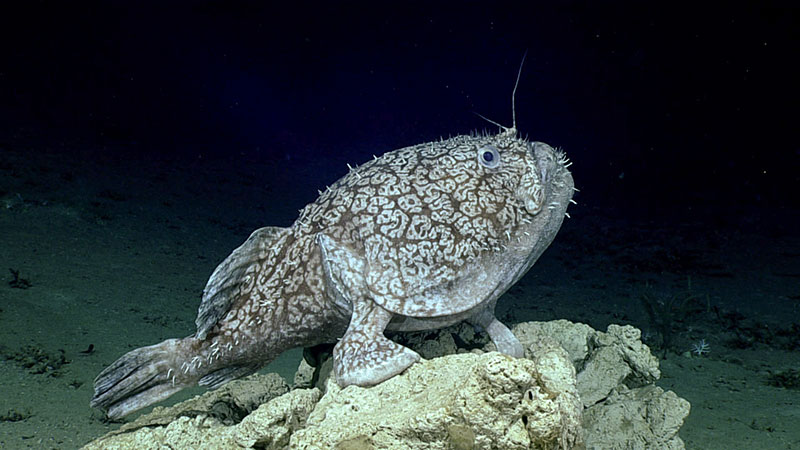
Striking a pose, this goosefish (Sladenia shaefersi) was among the first and favorite animals seen during Dive 12 of the 2019 Southeastern U.S. Deep-sea Exploration. Get a closer look in this video of the fish. Image courtesy of the NOAA Office of Ocean Exploration and Research, 2019 Southeastern U.S. Deep-sea Exploration. Download larger version (jpg, 1.0 MB).
On these features, we saw a number of different corals, both stony and soft, and both living and dead. The most prevalent stony coral was Enallopsammia. Among the soft corals was a yellow single-stalk bamboo coral (Lepidisis), the color of which is not typical of known species, so we collected it to see if it might be a new species and to learn more about it. We also saw a goosefish, a chimaera, rattails, squid, sea stars, brittle stars, crabs, shrimps, squat lobsters, and sponges.
On our way to the escarpment we encountered a ctenophore, a flapjack devilfish (Opisthoteuthis agassizii), and a giant isopod. Once there, we observed small blocks from the escarpment in the sediment at its base. These blocks had varying levels of crust. There was very little coral rubble.
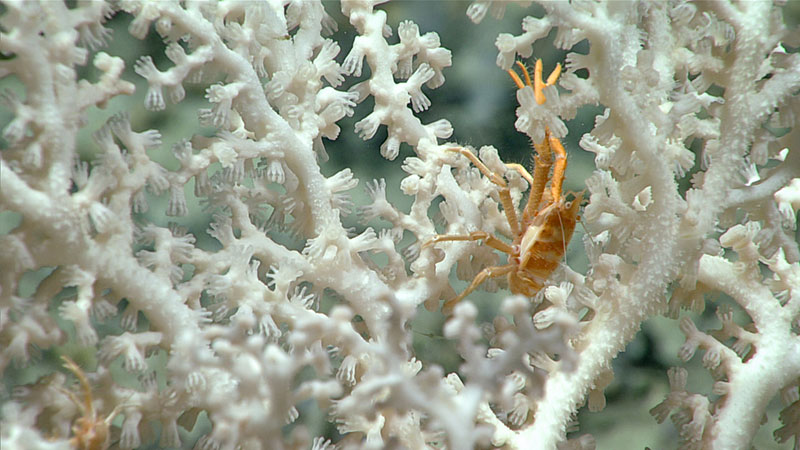
This intricate and robust octocoral (Corallidae) was seen on a largely sparse seafloor during Dive 12 of the 2019 Southeastern U.S. Deep-sea Exploration. Image courtesy of the NOAA Office of Ocean Exploration and Research, 2019 Southeastern U.S. Deep-sea Exploration. Download larger version (jpg, 973 KB).
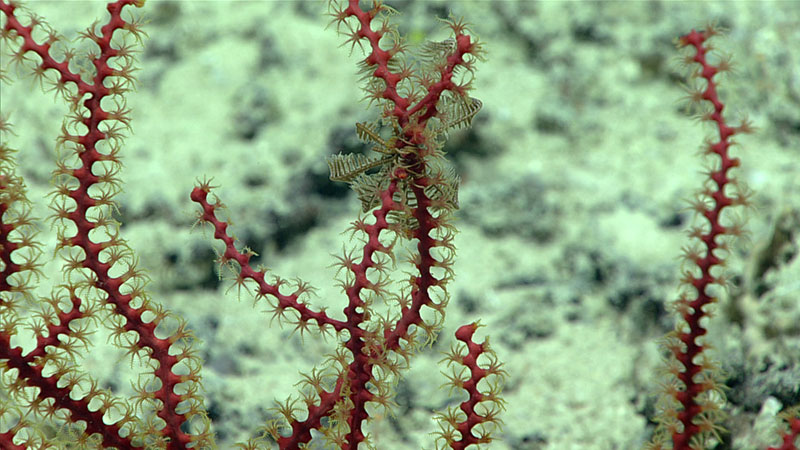
Like most octocorals, this Swiftia, which was seen During Dive 12 of the 2019 Southeastern U.S. Deep-sea Exploration, has eight tentacles on each of its polyps. Octocorals use these tentacles, which surround the polyps’ mouths, to catch food as it flows by in the current. Image courtesy of the NOAA Office of Ocean Exploration and Research, 2019 Southeastern U.S. Deep-sea Exploration. Download larger version (jpg, 947 KB).
On the escarpment, marine life was similar to what we saw previously on the dive, but we also observed a tripod fish, a pteropod, and feather stars. Notable sightings were a 20-30 centimeter (8-12 inch) Enallopsammia rostrata (a stony coral) and a sea star (cf. Floriaster maya), which we collected, that’s either a new species or represents the range extension of a known species from the Yucatán.
We also had two very special interactions today with NOAA leadership. During his visit to the Inner Space Center at the University of Rhode Island, Acting NOAA Administrator Neil Jacobs connected with the ship and spoke with Expedition Coordinator Mike White about the expedition and the importance of ocean exploration. Also, Deputy NOAA Administrator Tim Gallaudet called in to the science line while watching the live stream (and boarding a plane) to thank us for our work and tell us about the very successful White House Summit on Ocean Science and Technology. Both leaders expressed their great interest in and support for ocean exploration and teased a major forthcoming announcement from the administration as a result of the summit.
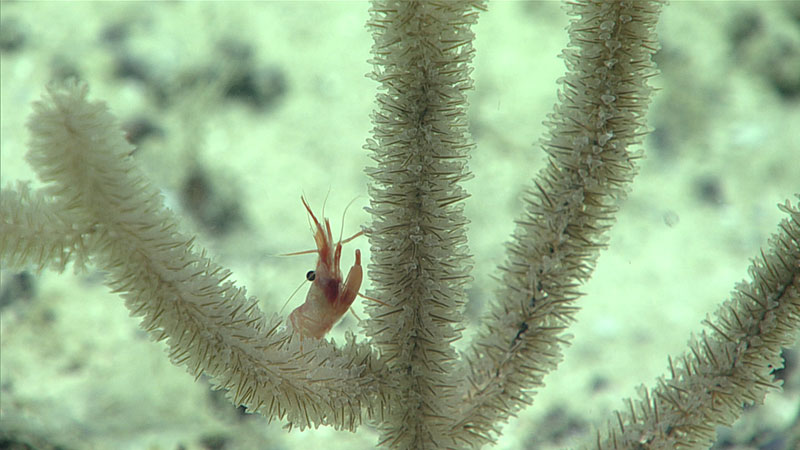
Black corals (Antipatharia) were seen during most, if not all, of the dives of the 2019 Southeastern U.S. Deep-sea Exploration. This one, with its densely packed polyps, was seen a few times on Dive 12 and was unfamiliar to our scientists. Image courtesy of the NOAA Office of Ocean Exploration and Research, 2019 Southeastern U.S. Deep-sea Exploration. Download larger version (jpg, 767 KB).

Location of Dive 12 of the 2019 Southeastern U.S. Deep-sea Exploration on November 19, 2019. Download larger version (jpg, 1.8 MB).
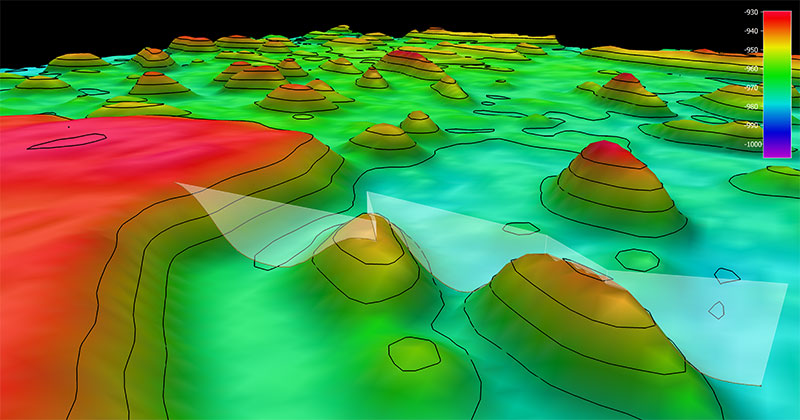
The remotely operated vehicle track for Dive 12 of the 2019 Southeastern U.S. Deep-sea Exploration, shown as an orange line with a white curtain. This mapping data was collected during the 2019 NOAA Ship Okeanos Explorer shakedown expedition. Legend shows water depth in meters. Download larger version (jpg, 4.1 MB).